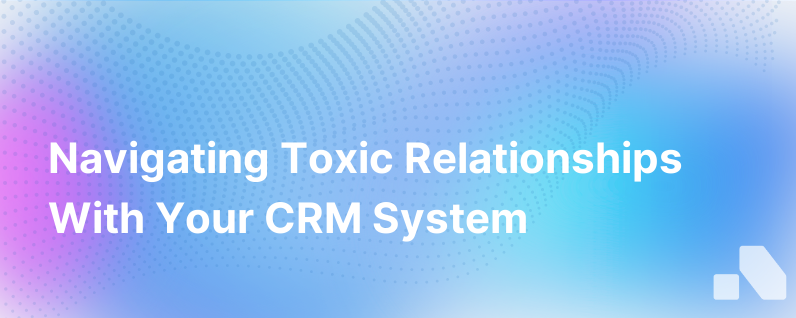From Love To Hate Navigating The Toxic Relationship With Your Crm
Published on July 11, 2023 by Sawyer Middeleer
In the world of B2B sales, Customer Relationship Management (CRM) software has become the quintessential tool for managing customer interactions, sales tracking, and a multitude of other critical business functions. Over time, these systems have evolved from simple contact management solutions to robust engines driving sales operations. However, the road to successful CRM implementation and ongoing engagement is fraught with challenges. For many sales professionals, the CRM that was once viewed as a beacon of efficiency and growth can morph into a source of frustration and inefficiency. This cascade from love to hate embodies the toxic relationship that some organizations develop with their CRM.
The Honeymoon Phase
Initially, companies fall in love with their CRM. The promise of a centralized platform where you can aggregate customer data, streamline communication, manage leads and opportunities, and automate sales processes is intensely alluring. During this 'honeymoon phase', it's easy to imagine how a CRM will propel your sales team to unparalleled heights. The wealth of data at your fingertips suggests a future powered by insights leading to better customer relationships and closed deals.
However, as with any relationship, the honeymoon can come to an abrupt end when reality doesn't meet expectations.
The Rocky Transition
After implementation, companies often find themselves in rocky territory. The CRM that was heralded as a panacea quickly becomes a source of frustration. Filling in endless fields, navigating clunky interfaces, and managing poor integration with other tools can transform the promise of simplicity into a labyrinth of complexity.
A litany of factors contributes to the deepening disenchantment:
- User adoption struggles: If the system isn't intuitive or doesn't integrate into existing workflows, sales reps will resist using it, leading to poor data quality.
- Inadequate Training: Without proper guidance and continued support, users can feel overwhelmed by the features and underutilize the CRM.
- Lack of Customization: A one-size-fits-all approach rarely works. If the CRM cannot be customized to reflect the unique processes of your business, it will feel restrictive and cumbersome.
- Overburdening with Data Entry: High expectations for data input can make CRM systems feel like administrative burdens rather than sales enablers.
- Poor Data Quality: A CRM is only as good as the data it holds. Inaccurate or outdated information can quickly derail sales efforts and lead to mistrust in the system.
- Insufficient Integration: CRM should work seamlessly with other business tools. Fragmented tech ecosystems can lead to inefficiencies and data silos.
Navigating The Toxicity
As frustration mounts and productivity drops, what started as a love affair may begin to sour. The key to navigating this period lies in understanding that the relationship with your CRM doesn't have to be an all-or-nothing affair. Here are actionable steps to mitigate the onset of toxicity:
Re-evaluate and Realign
Re-assess your CRM objectives and align them with your current business goals. This may involve restructuring your processes, data management practices, and integrating new functionalities that better serve your evolving needs.
Empower with Training
Invest in ongoing training and support structures for your team. Consider hiring or designating CRM champions within your team who can guide their peers, offer tips, and collate feedback for continuous improvements.
Customize and Integrate
Customization and integration capabilities can transform your CRM from a rigid system to a flexible tool tailored to your business. By embedding relevant processes, the CRM can become a natural extension of your daily operations.
Data Cleansing
Regularly cleanse data to ensure accuracy and usefulness. Instill a culture where quality data is everyone’s responsibility, and implement validation features within the CRM to maintain standards.
Simplify Data Entry
Reduce the burden of data entry through automation and smart data capture tools. This reduces the time sales reps spend on administrative tasks, allowing them to focus on selling.
Leadership and Culture
Leadership needs to exemplify the correct usage of the CRM and foster a data-driven culture where the CRM is central to business operations. Rewarding CRM engagement and mastery can also encourage wider adoption.
Feedback Loop
Establish a feedback loop with users to understand their pain points and successes. This ongoing dialogue can guide your CRM strategy and ensure it evolves with your teams' needs.
Review and Optimise
Regularly review your CRM's functionality and its impact on business outcomes. Be proactive in seeking out optimization opportunities to maintain a healthy CRM ecosystem.
Investing in A New Relationship
When all else fails, it may be time to consider transitioning to a different CRM solution. This decision shouldn't be taken lightly, but if your current system is stifling productivity rather than enhancing it, a migration might be the breath of fresh air your company needs.
In searching for a new CRM, prioritize flexibility, user-friendliness, integration capabilities, and consider looking for a system that offers intelligence and insight generation, like Aomni. A smart CRM doesn't just store data; it provides actionable insights, strategic recommendations, and supports decision-making. With a platform like Aomni, you can rejuvenate the passion your sales team has for data-driven selling, armed with the right tools to make account research, competitive analysis, and personalized sales content creation effortless and efficient.
Conclusion
Navigating the complex relationship with your CRM requires patience, strategic thinking, and a commitment to continuous improvement. It's about striking a balance between having a structured, data-rich system while ensuring usability and adoption among your sales team. Remember, your CRM should be a liberator, not a dictator, in your sales process. As you refine your CRM strategies or choose to move on to a better-aligned platform, never lose sight of the ultimate goal: to enhance your business relationships and drive sustainable growth.